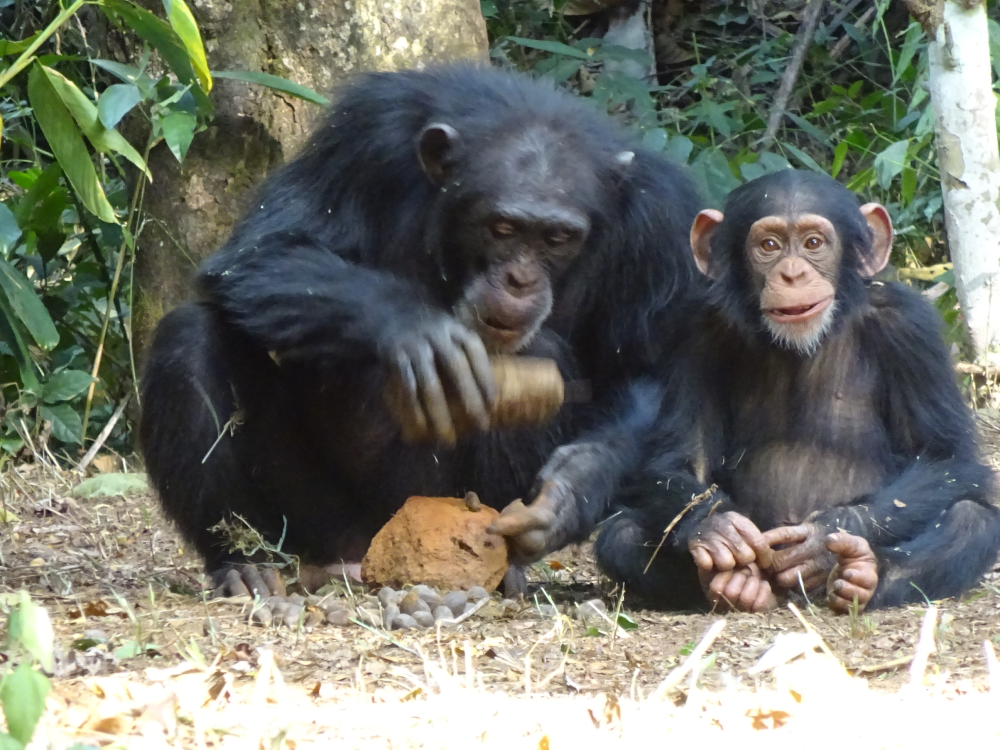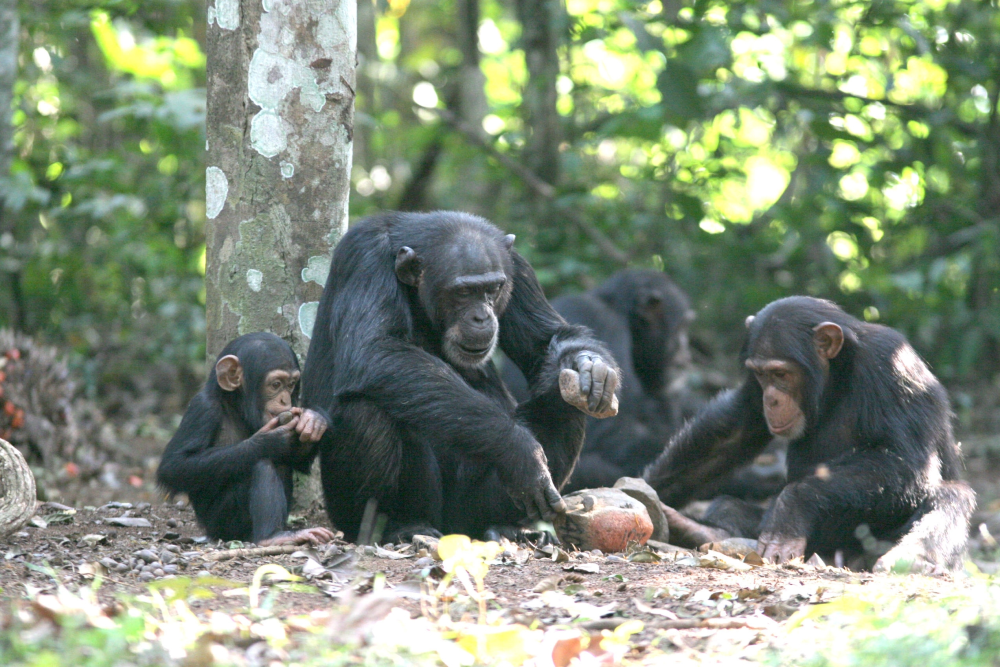A groundbreaking new study has opened the book on chimpanzee culture and its transmission, revealing compelling evidence that it is cumulative and spreads through social groups over generations. Using what they’re calling a “genetic time machine,” scientists have peered back into thousands of years’ worth of gene transfer, and spotted patterns between migrating females and the emergence of some of their most advanced examples of tool use. This demonstrates that advanced techniques don’t pop up randomly, but instead spread between social groups, gaining further reach over several generations.
Chimpanzee culture was first formally identified in the late 90s and we see evidence of it in examples of tool use – tool use that can range from the simple to the highly complex. Some techniques might require just one tool, like a rock, while others need precise toolsets, such as the way some chimpanzees catch termites using a combination of leaves and sticks.
How does chimpanzee culture develop and spread?
Among chimps, a simple idea may be invented independently in separate groups, but it can change as it gets built upon by several individuals and passed around, eventually developing into a complex toolset. This progression falls under cumulative culture, something we share with chimps, but where our culture seems to deviate from animals’ is in how flexible we are. This allows for development in many directions, rather than being limited to the capacity to build on previously transmitted cultural behaviors, as we see in chimpanzees.
It’s the females who transfer between communities, they spread their genes, but it can also spread cultures.
Prof Andrew Whiten
A 2015 study revealed how even though group members may come and go, the culture of tool use may endure in chimpanzees, such as the nut-crackers of Taï National Park, Côte d’Ivoire, in West Africa. When ideas do spread – particularly complicated ones – it falls to the females to transmit them, but as the nut-crackers of West Africa show, it can be a fragile mode of transmission. Why? Because moving into a new chimp scene isn’t always easy.

Nut-cracking among chimpanzees has shown how culture can stick even when new group members arrive with fresh ideas.
Image credit: Tetsuro Matsuzawa
“One difference that we see between humans and chimpanzees is that chimpanzees have a very hierarchical social structure within a group, whereas humans, or specifically hunter-gatherers, are very cooperative,” said lead author PhD candidate Cassandra Gunasekaram of the University of Zurich to IFLScience, whose supervisor Professor Andrea Migliano led the study. “In chimpanzees, we really see this hierarchical structure with dominance, and when a new female comes into a community, she is often low ranking. Either no one notices what she does, or she is hindered because others won’t really allow for her to express a certain behavior. Or it can also be that she might want to conform to the traditions in the new community.”
When the genetic data came out for the chimpanzees, we really just wanted to try this out to see if there was any pattern, and we actually found one.
Cassandra Gunasekaram
When a female reaches sexual maturity, she will leave her social group and find a new one as an adaptive behavior that reduces the chances of inbreeding. After arriving in her new community, a female may conform to their behaviors because she wants to fit in, not just for her own sake, but for her future offspring. Each time a female moves and reproduces, we see genetic transfer among neighboring groups more immediately, and then over millennia this can extend to more geographically distant groups.
A genetic time machine
This gave an international team of scientists the idea to go in search of the route of culture transmission by looking at the genetic history of chimpanzee populations, reaching back thousands of years into the past. This “genetic time machine,” as they called it, enabled them to overcome the obstacle of perishable tools that are hard to study because, well, they just don’t last that long. Gene transfer, on the other hand? That stuff sticks.
Does the culture correlate with that the way that females have migrated around? The magic result is yes.
Prof Andrew Whiten
“These modern genetic techniques have given us what I’m calling a genetic time machine to look into the past,” said study co-author Professor Andrew Whiten of the University of St Andrews to IFLScience. “It’s the females who transfer between communities, they spread their genes, but it can also spread cultures.”
“So, given we’ve got this now evidence which allows us to talk about the ancient genetic connections between all these populations, we can ask, “Does the culture correlate with that the way that females have migrated around?” And the magic result is yes, and that’s particularly true for the more complex behaviors, which is what we would predict if these complex behaviors are rarely invented, and therefore they’re mainly spread once they’re invented by perhaps just a few individuals, through cultural transmission. As these females move between communities, and then over centuries or millennia, they get spread far and wide.”

If chimps have cumulative culture, what does that tell us about the last common ancestor between them and us?
Image credit: Tetsuro Matsuzawa
Whiten joined Dr Jane Goodall and other chimpanzee experts in publishing the first systematic study to show that chimpanzees have culture in Nature back in 1999, a time when it seemed like a static picture and one that we’d never have the tools to dive deep into the history of. “I could never have believed when we did these other studies that we’d now know this,” said Whiten. “It just seemed like a closed book, but now the book is open.”
From great apes to early humans
It’s a book that’s going to extend into our own cultural origins, as Gunasekaram and her team at the Human Evolutionary Ecology Group are about to bring hunter-gatherers into the fold.
“Our research lab focuses on human evolution,” she said. “So, a similar study has been previously done on hunter-gatherers in Central Africa, and then when the genetic data came out for the chimpanzees, we really just wanted to try this out to see if there was any pattern, and we actually found one.”
The next step is to actually compare the extent of migration patterns and inter-group connectivity between humans and chimpanzees.
Cassandra Gunasekaram
Finding evidence for chimpanzees’ capacity to accumulate culture raises questions about its evolutionary history as a trait. If it goes as far back as chimps, then could it go as far back as the last common ancestor of humans and chimps? And if so, was it also limited by social systems and migration patterns? That’s what the team hopes to find out.
“The next step is to actually compare the extent of migration patterns and inter-group connectivity between humans and chimpanzees,” said Gunasekaram, “and then quantify the complexification of the cultural traits that we see in both species, to get a proper understanding of the differences in these processes that are linked to cumulative culture.”
A new branch of conservation
As if lifting the lid on the evolutionary history of cumulative culture weren’t enough, the research has also caught the eye of the United Nations’ Environment Program in highlighting that it might be time we start to consider the preservation of animal culture, as well as biodiversity. The new approach to conservation could extend to many migratory animal groups – including whales, birds, and ungulates – in addressing the need to agree on an approach that spans multiple countries as, unlike government regulations, wildlife has little consideration for borders.
We’re trying to support biodiversity, [but] you need to also be thinking about conserving cultural diversity.
Prof Andrew Whiten
“In 2019, a COP in India approved a Concerted Action to be pursued by the relevant chimpanzee range states in West Africa, to conserve an endangered culture that exists there, in which chimpanzees use natural hammer materials to crack open nuts,” explained Whiten. “In 2024, this has been superseded by a more ambitious Concerted Action to conserve chimpanzee cultural diversity more widely across Africa.”
“This builds on the idea that, in conservation, we’re trying to support biodiversity, but then if you’ve got a species that’s as cultural as we now know chimpanzees are, that translates into: you need to also be thinking about conserving cultural diversity. That’s where a lot of the effort is at the moment, and that’s only going to be manifested through interactions with a lot of local communities, Indigenous Peoples, organizations at several levels, from the United Nations and the International Union for the Conservation of Nature (IUCN) down. No one’s quite sure how we can do that just yet, but they recognize that it’s probably very important we do.”
The study was conducted by the Human Evolutionary Ecology Group at the University of Zurich, and is published in Science.
Source Link: Groundbreaking “Genetic Time Machine” Reveals Evidence Of Cumulative Culture In Chimpanzees